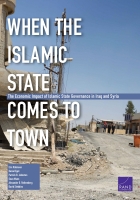by Eric Robinson
How effective is Islamic State governance?
 At its peak, the Islamic State of Iraq and the Levant (ISIL) controlled vast portions of territory in Iraq and Syria with several million inhabitants. ISIL's territorial ambition and desire to conduct state-like governance over this territory are integral to its global ideological appeal. By examining ISIL's impact on local economic activity in Iraq and Syria, this report seeks to assess the effectiveness of ISIL's governance over its self-styled caliphate.
At its peak, the Islamic State of Iraq and the Levant (ISIL) controlled vast portions of territory in Iraq and Syria with several million inhabitants. ISIL's territorial ambition and desire to conduct state-like governance over this territory are integral to its global ideological appeal. By examining ISIL's impact on local economic activity in Iraq and Syria, this report seeks to assess the effectiveness of ISIL's governance over its self-styled caliphate.
This report leverages remote sensing data and commercial satellite imagery to offer a unique, data-driven look inside areas controlled by the Islamic State. It paints a bleak picture of economic life under ISIL, replete with shortages of electricity, massive refugee flows, reductions in agricultural output, and upticks in violence all associated with ISIL control.
At times, ISIL was able to build a dense governing apparatus that helped maintain stable local commercial activity, particularly in its strategic capitals in Raqqah and Mosul. At other times, ISIL mismanaged key resources or sought to punish its citizenry rather than govern it. However, this report suggests that decaying economic conditions in ISIL-held territory are also a product of ISIL's inability to insulate its territory from opposing military forces. Outside pressure against ISIL successfully prevented the group from realizing its governing ambitions across significant parts of its caliphate, with major consequences for its ability to support functioning local economies.
This report is important for those trying to understand the group's impact on local populations in Iraq and Syria, for those seeking to counter its financing or conduct post-conflict stabilization, and for broader efforts to understand the economic impact of insurgent governance.
Key Findings
Military Pressure on ISIL-Held Areas Has Dampened Economic Activity and Prevented ISIL from Fully Governing According to Its Stated Goals
This pressure has contributed to significant economic decay in ISIL-held territory and limits ISIL's ability to profit from taxation and gain popular legitimacy.
ISIL's Strict Governance Is Not Necessarily Self-Defeating
Local economies that struggled under ISIL control did so not because taxes were too high or social regulations too restrictive. The struggles largely coincided with military efforts to disrupt ISIL control.
ISIL Showed Signs of Successful Stewardship over Local Economies but Also Signs of Incompetence and Indifference
In multiple cities, ISIL prioritized electricity provision to hospitals and key infrastructure even in the face of larger electricity shortages.
Electricity Consumption Has Suffered the Most of All Economic Activity Under ISIL Control
Electricity consumption in ISIL-held areas showed the most-significant declines from pre-ISIL levels of activity.
After liberation, these effects linger.
Flows of Internally Displaced Persons Begin Well Prior to Liberation
Planning for liberation of ISIL-held cities must take into account the fact that these flows begin well before the first military forces enter an ISIL-held city.
Markets Do Not Return to Normal Activity Immediately After a City Is Liberated
Markets are partially damaged by fighting during ISIL's retreat and appear largely empty following liberation because residents fled the fighting.
Bureaucratic Capacity Likely Remains in Areas Liberated from ISIL
Liberating forces are likely to encounter local doctors, engineers, and bureaucrats who either voluntarily worked for ISIL or were co-opted into doing so.
Given that ISIL's strict governance is not necessarily self-defeating, military efforts to retake its remaining territory and prevent a resurgence of the group remain critically important.
Stabilization planning for the liberation of areas still controlled by ISIL should focus on procuring power supplies and rebuilding energy infrastructure. Implementers should be prepared to provide this assistance well beyond the first few months after liberation.
Planning for humanitarian assistance surrounding liberation must take into account the location and unique needs of internally displaced persons.
Stabilization planning should focus on working with liberating forces to effectively and fairly distinguish between ISIL sympathizers and unsympathetic locals with the needed institutional knowledge to help provide public services after cities are liberated.
No comments:
Post a Comment